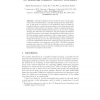Free Online Productivity Tools
i2Speak
i2Symbol
i2OCR
iTex2Img
iWeb2Print
iWeb2Shot
i2Type
iPdf2Split
iPdf2Merge
i2Bopomofo
i2Arabic
i2Style
i2Image
i2PDF
iLatex2Rtf
Sci2ools
IH
2005
Springer
2005
Springer
Data Hiding in Compiled Program Binaries for Enhancing Computer System Performance
Abstract. Information hiding has been studied in many security applications such as authentication, copyright management and digital forensics. In this work, we introduce a new application where successful information hiding in compiled program binaries could bring system-wide performance improvements. Our goal is to enhance computer system performance by providing additional information to the processor, without changing the instruction set architecture. We first analyze the statistics of typical programs to demonstrate the feasibility of hiding data in them. We then propose several techniques to hide a large amount of data in the operand fields with very low computation and storage requirements during the extraction process. The data embedding is made reversible to recover the original instructions and to ensure the correct execution of the computer program. Our experiments on the SPEC CPU2000 benchmark programs show that up to 110K bits of information can be embedded in large prog...
IH 2005 | Information Hiding | Instruction Set Architecture | System-wide Performance Improvements |
| Added | 27 Jun 2010 |
| Updated | 27 Jun 2010 |
| Type | Conference |
| Year | 2005 |
| Where | IH |
| Authors | Ashwin Swaminathan, Yinian Mao, Min Wu, Krishnan Kailas |
Comments (0)

